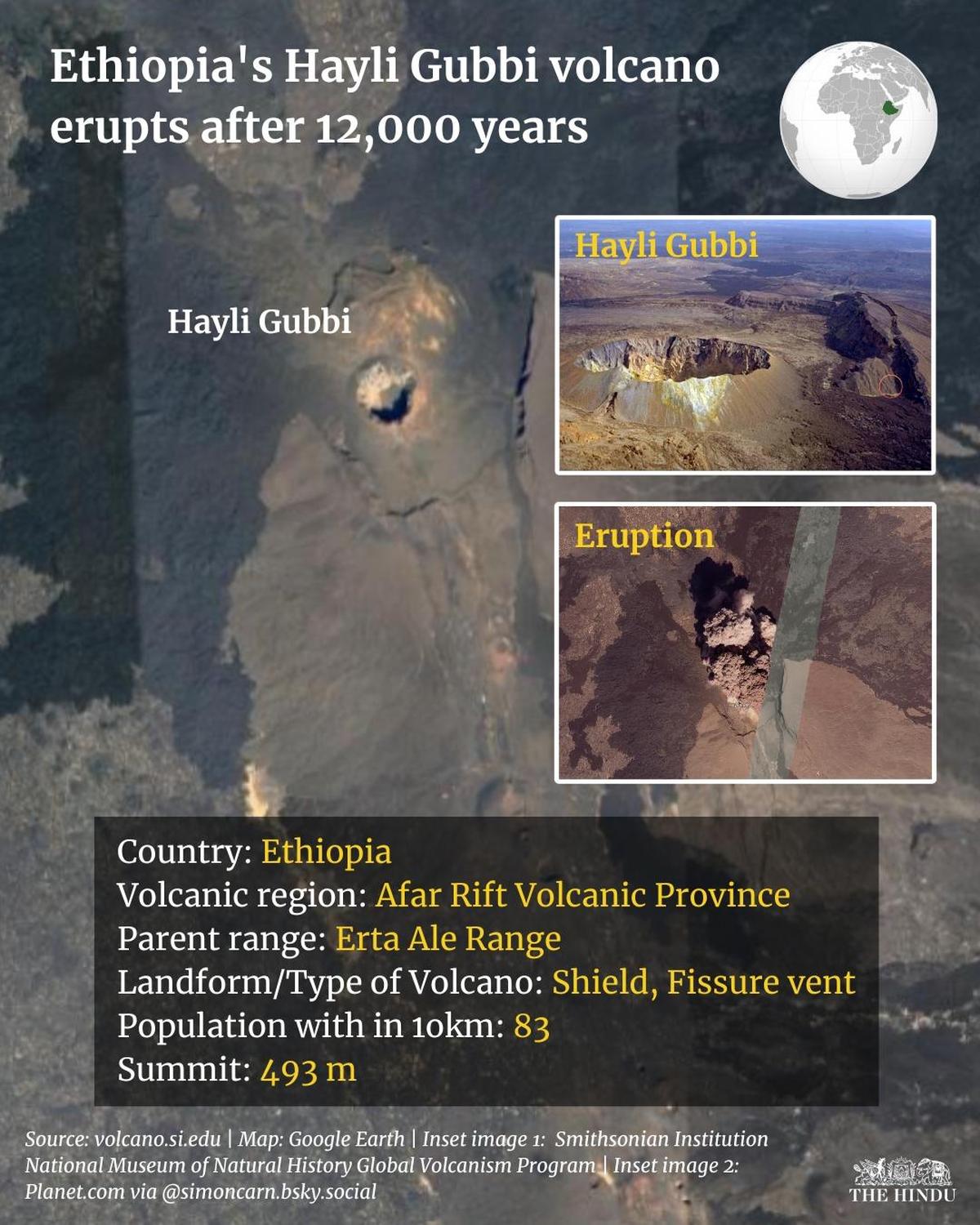Context:
Ethiopia’s Hayli Gubbi volcano, located in the Afar Region, erupted on November 23, 2025, for the first time in recorded history. The eruption sent ash plumes up to 14 km into the atmosphere. The ash cloud from the eruption spread across the Red Sea, reaching Yemen, Oman, Pakistan, and northern India.
About Hayli Gubbi Volcano:
· Hayli Gubbi is a shield volcano in the Afar Region of northeastern Ethiopia.
· It is part of the Erta Ale Range and is the southernmost volcano in this chain.
· The volcano lies in a tectonically active rift zone - specifically, the Afar Rift, which is part of the larger East African Rift System.
· The Afar Rift is a triple‑junction area, where three tectonic plates (the Nubian, Somali, and Arabian plates) are diverging, making it geologically very unstable and volcanically active.
About Volcano:
A volcano is a rupture in the Earth's crust where molten rock, gases, and ash are expelled from beneath the surface. The molten rock is called magma when inside the Earth surface and lava once it reaches the surface.
Formation of Volcanoes:
Volcanoes are primarily formed due to:
1. Tectonic Plate Boundaries:
o Divergent boundaries: Plates move apart; magma rises to fill the gap (e.g., Mid-Atlantic Ridge).
o Convergent boundaries: One plate subducts beneath another; magma forms from melting of subducted material (e.g., Pacific Ring of Fire).
2. Hotspots: Magma rises from deep within the mantle, independent of plate boundaries (e.g., Hawaii).
Types of Volcanoes:
1. Shield Volcano: Broad, gently sloping; formed from fluid lava flows (e.g., Mauna Loa, Hawaii).
2. Composite or Stratovolcano: Steep, conical; alternates between lava flows and explosive eruptions (e.g., Mount Fuji, Vesuvius).
3. Cinder Cone: Small, steep-sided; formed from ash, cinders, and volcanic rocks (e.g., Paricutin, Mexico).
4. Lava Dome: Dome-shaped, formed from viscous lava that piles near the vent (e.g., Mount St. Helens lava dome).
Volcanic Materials:
-
- Lava: Molten rock flowing on the surface.
- Pyroclastic materials: Ash, cinders, volcanic bombs.
- Gases: Carbon dioxide, sulfur dioxide, water vapor, hydrogen sulfide.
- Lava: Molten rock flowing on the surface.
Volcanic Landforms:
Volcanic activity creates:
-
- Calderas: Large depressions formed after volcanic eruption and collapse.
- Crater: Bowl-shaped depression at the top of a volcano.
- Lava plateaus: Formed from repeated lava flows over large areas.
- Volcanic islands: Created by underwater eruptions (e.g., Iceland, Azores).
- Calderas: Large depressions formed after volcanic eruption and collapse.
Beneficial Effects of Volcanoes:
-
- Fertile soil: Volcanic ash enriches soil for agriculture.
- Mineral resources: Lava and volcanic rocks provide minerals like pumice, basalt, and gold deposits.
- Geothermal energy: Heat from magma can generate electricity (e.g., Iceland).
- Tourism: Volcanoes attract tourists, boosting local economy.
- Fertile soil: Volcanic ash enriches soil for agriculture.
Volcanoes in India
-
- Barren Island (Andaman & Nicobar): Only active volcano in India.
- Narcondam (Andaman & Nicobar): Dormant volcanic island.
- Trekking and geological study sites: Deccan Plateau basalts are remnants of ancient volcanic activity.
- Barren Island (Andaman & Nicobar): Only active volcano in India.







